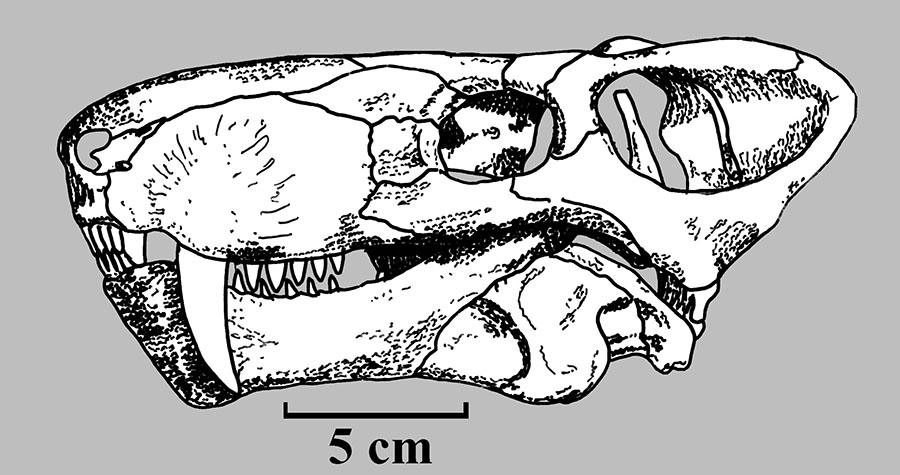
Species: progressus (HARTMANN-WEINBERG, 1938) BYSTROW, 1955
Etymology:
= Arctognathus progressus HARTMANN-WEINBERG, 1938
= Inostrancevia progressus (HARTMANN-WEINBERG, 1938) EFREMOV, 1940
Lectotype: PIN 156/5
Locality: Semin Ovrag Locality, Semin (Syomin) Ovrag Ravine, Cemin Ravin, village of Il’inskoe, right bank of the Volga River, Tetyushi District, Tatarstan, European Russia.
Horizon: Serverodvinian (Dvina) horizon, Semen Formation.
Biostratigraphy: Sokolki Faunal Assemblage, Ilinskoe Faunal Subassemblage.
Age: Upper Tatarian Age, Lopingian Subepoch, upper Zechstein Epoch, Late Permian.
Material: Skull.

Referred material:
PIN 156/6: Fragmentary skull, mandible and anterior part of the skeleton.
PIN 156/7, 156/8: Left maxillae.
PIN 156/9, 52-55: Right dentaries.
PIN 156/26: Skull fragment.
PIN 156/38-40: Canines.
PIN 156/51: Half of a skull.
PIN 156/56: Right mandible, ramus.
PIN 156/57: An occiput.
PIN 156/58, 156/59, 156/65: Left squamosals.
PIN 156/60: Postcanine fragment.
PIN 156/67: Right maxilla.
PIN 156/70: Right angular.
_____________________________________________________________________________________
Species: parringtoni (HUENE, 1950) GEBAUER, 2014
Etymology: In honor of British paleontologist Dr. Francis Rex Parrington
= Scymnognathus parringtoni HUENE, 1950
= Aelurognathus? parringtoni (HUENE, 1950)
SIGOGNEAU, 1970
Holotype: GPIT/RE/7113 (old IGP U 28)
Locality: Usili-Berges, Ruhuhu Valley, Tanzia, Tanganyika, East Africa.
Horizon: Hoedemaker member, Middle Teekloof Formation.
Biostratigraphy: Tropidostoma zone (Tropidostoma-Endothidon Assemblage zone KEYSER, 1979, SACS, 1980, Tropidostoma microtrema zone KEYSER & SMITH, 1977-78, Lower Cistecephalus zone KITCHING, 1970, 1977, Endothiodon zone, WATSON, 1914).
Age: Tatarian Age, Lopingian Subepoch, Zechstein Epoch, Late Permian.
Material: Skull and dentary and fragmentary skeleton.
Note: Has a dentary of Katumbia parringtoni in its stomach region (MAISCH,
2009).